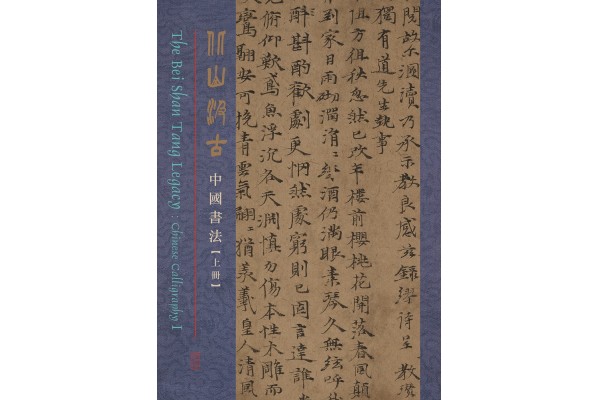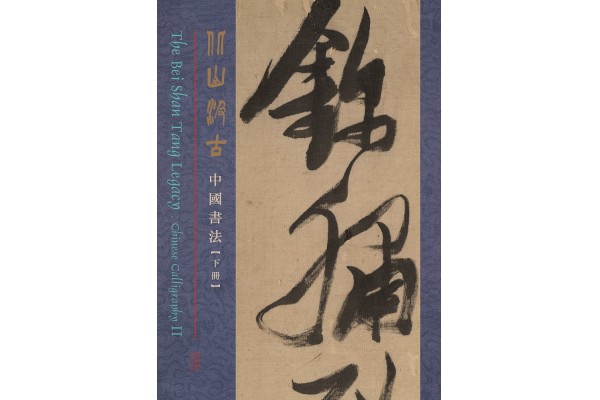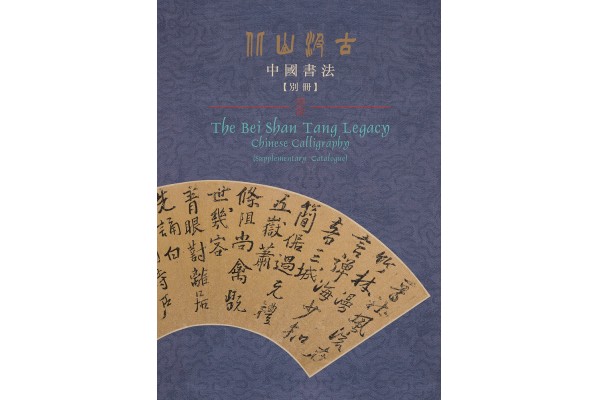The Bei Shan Tang Legacy: Chinese Calligraphy
Researcher
MOK Kar Leung Harold
Duration
2011-2014
Content
This project is a study of the calligraphic works previously and currently collected by the Bei Shan Tang, with the output in the form of a catalogue in three volumes. The catalogue includes 9 articles and the entries of 100 pieces of selected calligraphic works, which are bilingual in Chinese and English, as well as the transcription of all the texts and colophons of the works. The production of the catalogue is funded by the Bei Shan Tang Foundation. Related activities include an exhibition, talks, symposiums, etc.
Bei Shan Tang, originally the studio name of the late Dr. Lee Jung Sen, has come to identify an impressive collection of Chinese art and antiquities, many of which have been gifted to the Art Museum, The Chinese University of Hong Kong, since the 1970s. This project aims to study in detail the calligraphic works previously and currently collected by the Bei Shan Tang collection. With the critical selection of 100 pieces of calligraphy dated from the Tang to the Qing, including Buddhist sutras, poems, letters, couplets, essays, manuscripts, and even a memorial in blood and a loan agreement by calligraphers who might be an emperor, a master, a personage, a litterateur or a monk, this project helps shed light on the art of Chinese calligraphy by the inclusion of entries and the transcription of inscriptions and colophons for each work as well as nine articles on various topics. The output is a catalogue in three volumes, which are bilingual in Chinese and English except the transcriptions. The contributors of articles, except the Principal Investigator, are all alumni of the postgraduate programme of the Department of Fine Arts, The Chinese University of Hong Kong, while those who produce the entries are the Ph.D students of the Department. The production of the catalogue is funded by the Bei Shan Tang Foundation. Related activities include an exhibition, symposiums, lectures, etc.
-
Publications
- Mok, Harold. “Xianggong Zhongwen Daxue Wenwuguan cang Wang Chung Jiequanjuan (Wang Chong’s Loan Agreement in the collection of the Art Museum, The Chinese University of Hong Kong).” In Li Yu-chou ed., Shanggu yu shangtai: Yuan Ming shufa yanjiu lunji (Taipei: Wanjuanlou tushu gufen youxian gongsi, 2013), pp. 325-358.
- Xia Xiaoshuang. “Jiguang pianyu, huicui Zhongda: ‘Beishan jigu: Zhongguo shufa” zhanlan jieshao (shang) (Art treasures at The Chinese University of Hong Kong: An introduction to the exhibition ‘The Bei Shan Tang Legacy: Chinese Calligraphy [1]’).” Daguan, no. 58 (July 2014), pp. 102-107.
- Xia Xiaoshuang. “Jiguang pianyu, huicui Zhongda: ‘Beishan jigu: Zhongguo shufa” zhanlan jieshao (xia) (Art treasures at The Chinese University of Hong Kong: An introduction to the exhibition ‘The Bei Shan Tang Legacy: Chinese Calligraphy [2]’).” Daguan, no. 61 (October 2014), pp. 104-109.
Catalogue and Its articles:
- Mok, Harold ed. The Bei Shan Tang Legacy: Chinese Calligraphy. Hong Kong: Art Museum and Department of Fine Arts, The Chinese University of Hong Kong, 2014. (bilingual in Chinese and English)
- Mok, Harold. “Inheritance, Integrity and Courtesy: A Survey of Chinese Calligraphy through the Bei Shan Tang Collection.” Translated by Tina Liem. In Harold Mok ed., The Bei Shan Tang Legacy: Chinese Calligraphy (Hong Kong: Art Museum and Department of Fine Arts, The Chinese University of Hong Kong, 2014), Book 1, pp. 10-15, Supplementary Catalogue, pp. 7-12. (bilingual in Chinese and English) Chinese version also in Zhongguo shufa, no. 8, 2014, pp. 51-79; Zhongguo shuhua, no. 143 (November 2014), pp. 5-11.
- Mao, Qiujin. “Sutra Copying and Sutra Calligraphy of the Tang Dynasty.” Translated by Yan Tsz-ting. In Harold Mok ed., The Bei Shan Tang Legacy: Chinese Calligraphy (Hong Kong: Art Museum and Department of Fine Arts, The Chinese University of Hong Kong, 2014), Book 1, pp. 18-27, Supplementary Catalogue, pp. 15-25. (bilingual in Chinese and English)
- Tang, Raymond. “A Reading of Shen You’s Encomium to Doctor Shen Boxin in Regular Script.” Translated by Tina Liem. In Harold Mok ed., The Bei Shan Tang Legacy: Chinese Calligraphy (Hong Kong: Art Museum and Department of Fine Arts, The Chinese University of Hong Kong, 2014), Book 1, pp. 44-49; Supplementary Catalogue, pp. 27-31. (bilingual in Chinese and English) Chinese version also in Zhongguo shufa, no. 8, 2014, pp. 85-93.
- Chui, Lisa. “Dong Qichang’s Copying of and Insights from the Preface to Sacred Teachings.” Translated by Tina Liem. In Harold Mok ed., The Bei Shan Tang Legacy: Chinese Calligraphy (Hong Kong: Art Museum and Department of Fine Arts, The Chinese University of Hong Kong, 2014), Book 1, pp. 106-115; Supplementary Catalogue, pp. 33-39. (bilingual in Chinese and English)
- Yeung, Sara. “Bei Shan Tang’s Collection of Personage Chidu and Chidu Collection in the Ming-Qing Times.”Translated by Hui King-sze, Kasey. In Harold Mok ed., The Bei Shan Tang Legacy: Chinese Calligraphy (Hong Kong: Art Museum and Department of Fine Arts, The Chinese University of Hong Kong, 2014), Book 1, pp. 116-129; Supplementary Catalogue, pp. 41-54. (bilingual in Chinese and English) Chinese version also in Zhongguo shufa, no. 8, 2014, pp. 118-135.
- Cheung, Wai-yee. “The Year 1622: Zhang Ruitu and The Han Capital.” Translated by Tina Liem. In Harold Mok ed., The Bei Shan Tang Legacy: Chinese Calligraphy (Hong Kong: Art Museum and Department of Fine Arts, The Chinese University of Hong Kong, 2014), Book 2, pp. 252-261; Supplementary Catalogue, pp. 55-62. (bilingual in Chinese and English) Chinese version also in Zhongguo shuhua, no. 143 (November 2014), pp. 20-48.
- Ho, Pik-ki. “Poems in Running Script by Liang Tongshu and Weng Fanggang: A Political and Cultural Narrative of Mid-Qing Calligraphy.” Translated by Au Ka-yan, Kathy. In Harold Mok ed., The Bei Shan Tang Legacy: Chinese Calligraphy (Hong Kong: Art Museum and Department of Fine Arts, The Chinese University of Hong Kong, 2014), Book 21, pp. 340-351; Supplementary Catalogue, pp. 63-73. (bilingual in Chinese and English)
- Chen, Yafei. “Life and Art of the Qianlong-Jiaqing Literatus Zhao Huaiyu.” Translated by Tina Liem. In Harold Mok ed., The Bei Shan Tang Legacy: Chinese Calligraphy (Hong Kong: Art Museum and Department of Fine Arts, The Chinese University of Hong Kong, 2014), Book 2, pp. 352-359; Supplementary Catalogue, pp. 75-82. (bilingual in Chinese and English)
- Cheung, Ngai-yee. “Mired in the Waters of Dulu: Life and Calligraphy of the Guangdong Loyalist Chen Gongyin.” Translated by Yan Tsz-ting. In Harold Mok ed., The Bei Shan Tang Legacy: Chinese Calligraphy (Hong Kong: Art Museum and Department of Fine Arts, The Chinese University of Hong Kong, 2014), Book 2, pp. 460-471; Supplementary Catalogue, pp. 83-93. (bilingual in Chinese and English)
-
Exhibitions
“The Bei Shan Tang Legacy: Chinese Calligraphy.” Co-organized by Art Museum and Department of Fine Arts, The Chinese University of Hong Kong. First phase: 12 April – 3 August, 2014; second phase: 8 August – 20 November.
-
Conferences
- Mok, Harold. “Wang Chong’s Loan Agreement in the Collection of the Art Museum, The Chinese University of Hong Kong.” Paper presented in “International Conference of Yuan and Ming Calligraphy” organized by Ming Dao University, Taiwan. 27 March, 2013. (in Chinese)
- “Symposium of ‘The Bei Shan Tang Legacy: Chinese Calligraphy’.” Co-organized by Department of Fine Arts and Art Museum, The Chinese University of Hong Kong. 16 October, 2014. (in Chinese)
-
Talks
- Mok, Harold. “Chen Chun and Wang Chong in the History of Calligraphy: As Inspired by the Two Pieces of Thousand-Character Essay in the Bei Shan Tang Collection.” Open lecture co-organized by the University Museum and Art Gallery and The University of Hong Kong Museum Society, 13 May, 2013. (in Chinese)
- Bai Qianshen. “Calligraphy in the Everyday Life of Late Qing Government Officials.” “‘The Bei Shan Tang Legacy: Chinese Calligraphy’: Talk Series by Masters” co-organized by the Bei Shan Tang Foundation, Art Museum and Department of Fine Arts of the Chinese University of Hong Kong. 30 July, 2014. (in Chinese)
- Mok, Harold. “On Several Issues of the History of Chinese Calligraphy as Viewed from the Collection of Bei Shan Tang.” “Forum on History of Chinese Calligraphy 2014 in Suzhou (Wujiang), China” co-organized by Chinese Calligraphers Association, Joint Association of Literature and Art of the Jiangsu Province, Jiangsu Provincial Federation of Literary and Art Circles, Suzhou Federation of Literary and Art, and the People’s Government of the Wujiang, 20 July, 2014. (in Chinese)
- Mok, Harold. “Inspiration from the Calligraphic Works Collected by the Bei Shan Tang.” “‘The Bei Shan Tang Legacy: Chinese Calligraphy’: Talk Series by Masters” co-organized by the Bei Shan Tang Foundation, Art Museum and Department of Fine Arts of the Chinese University of Hong Kong. 4 October, 2014. (in Chinese)






